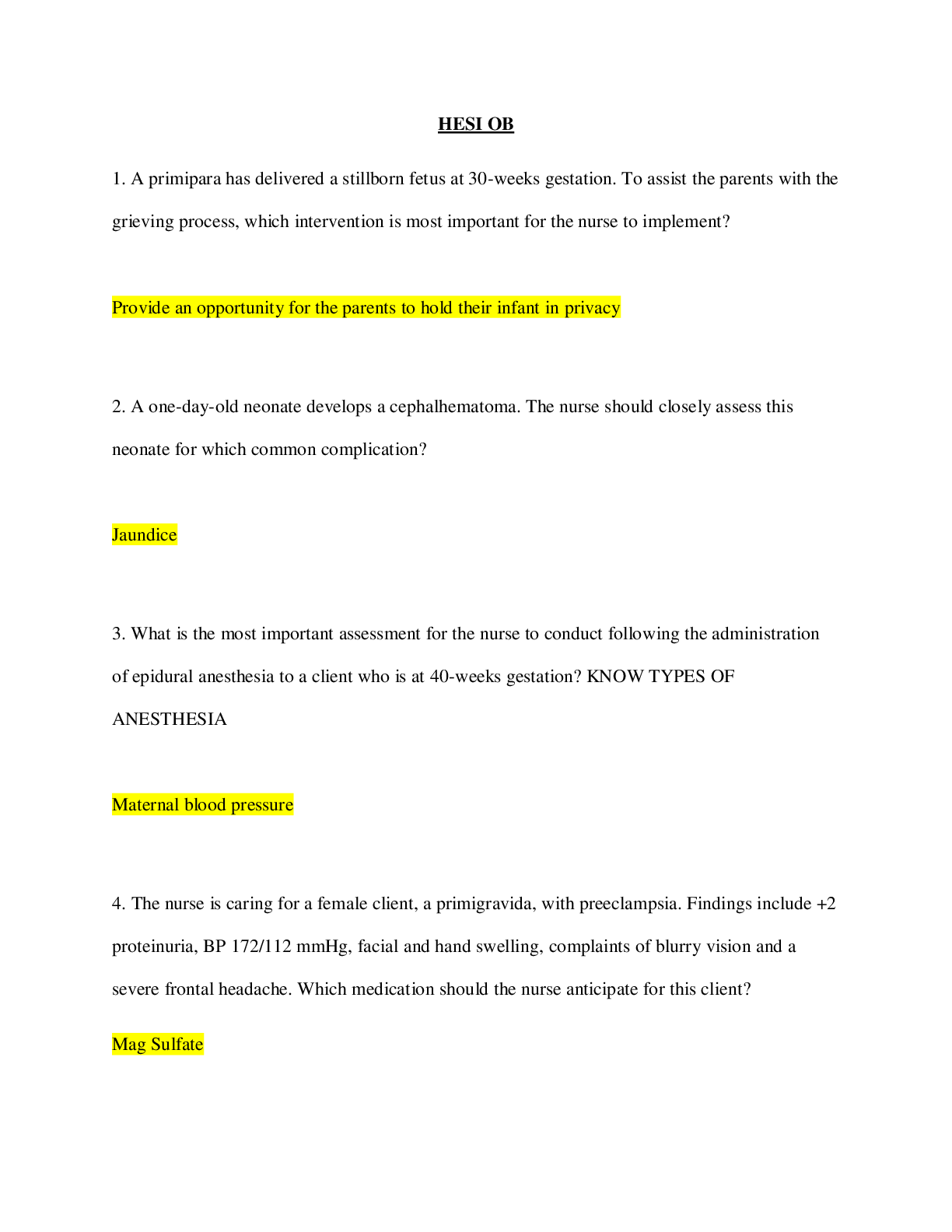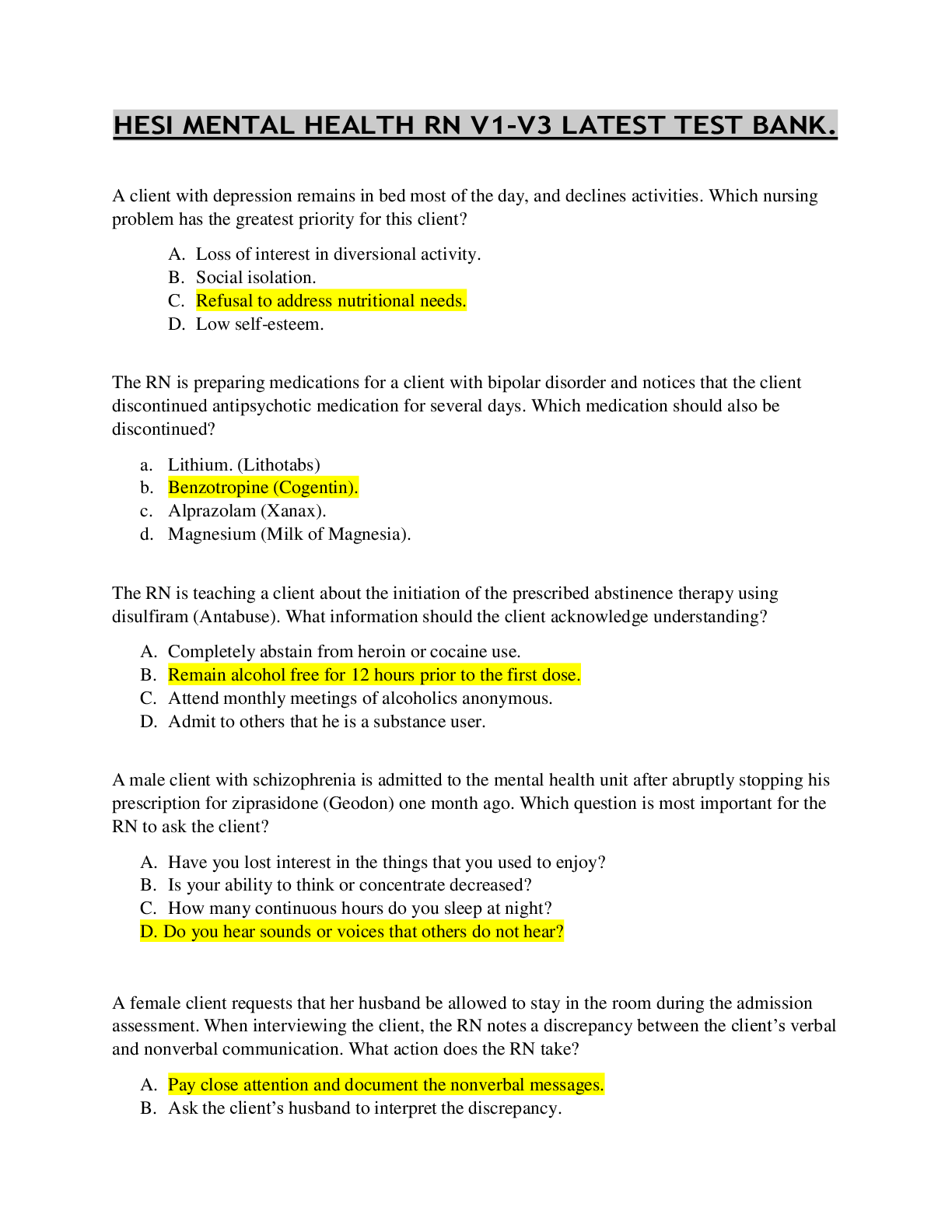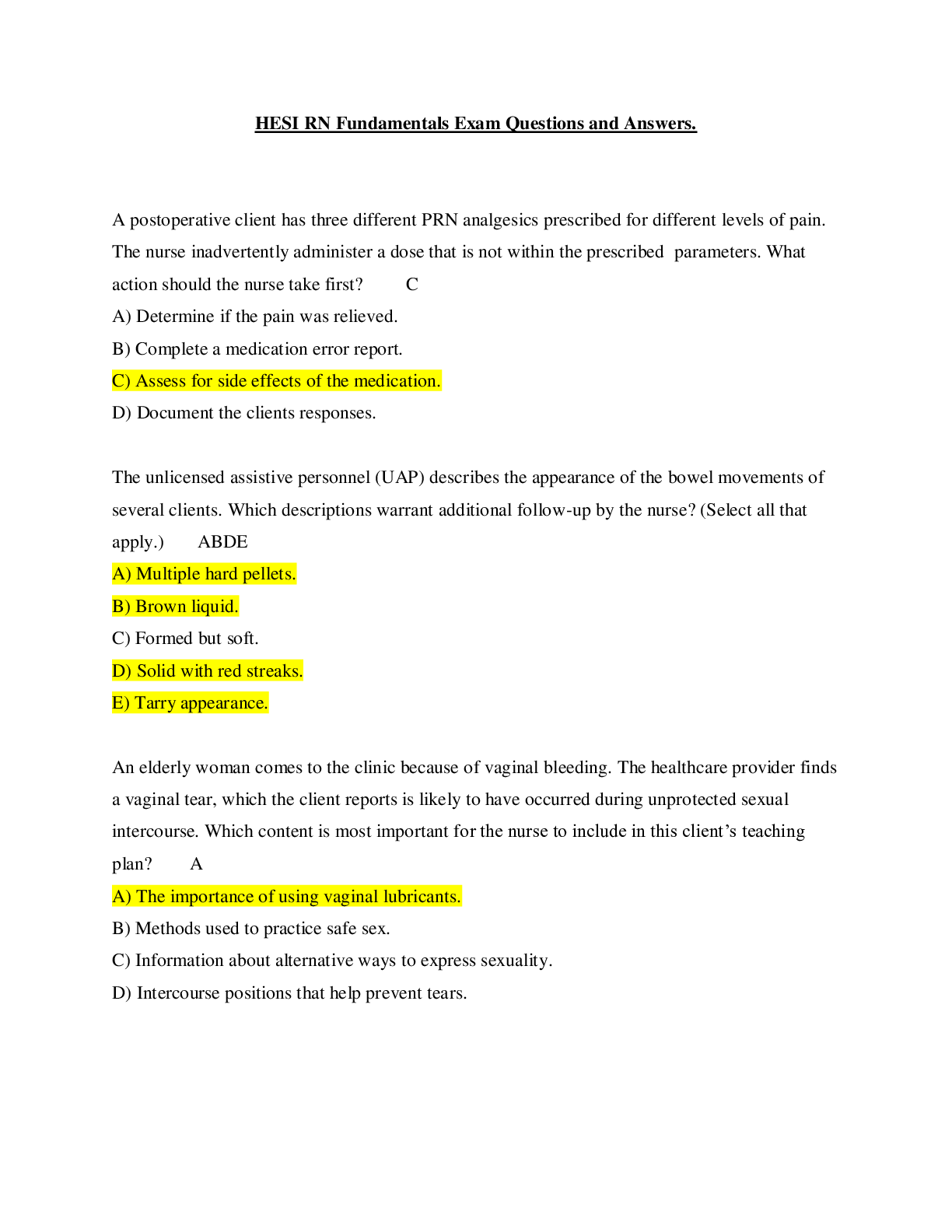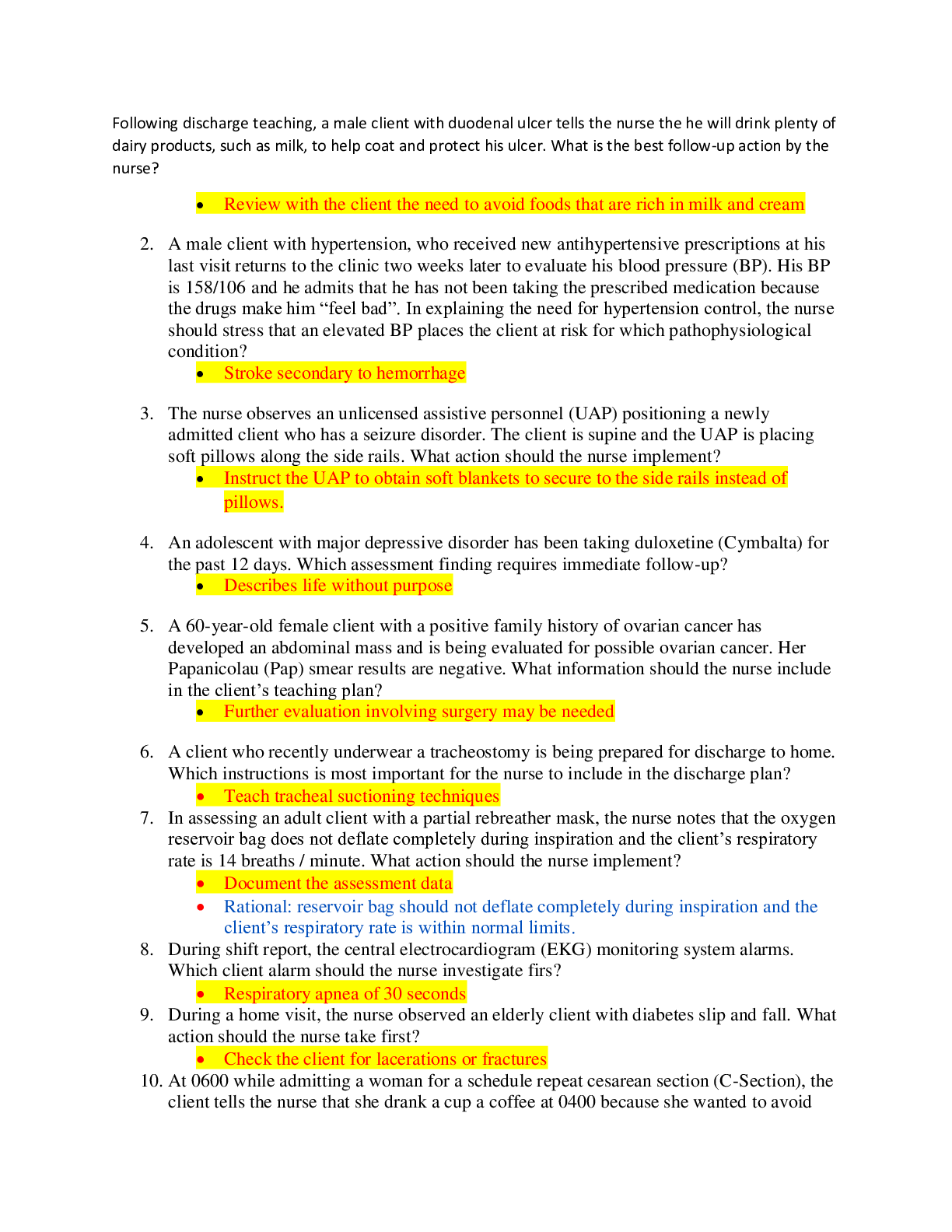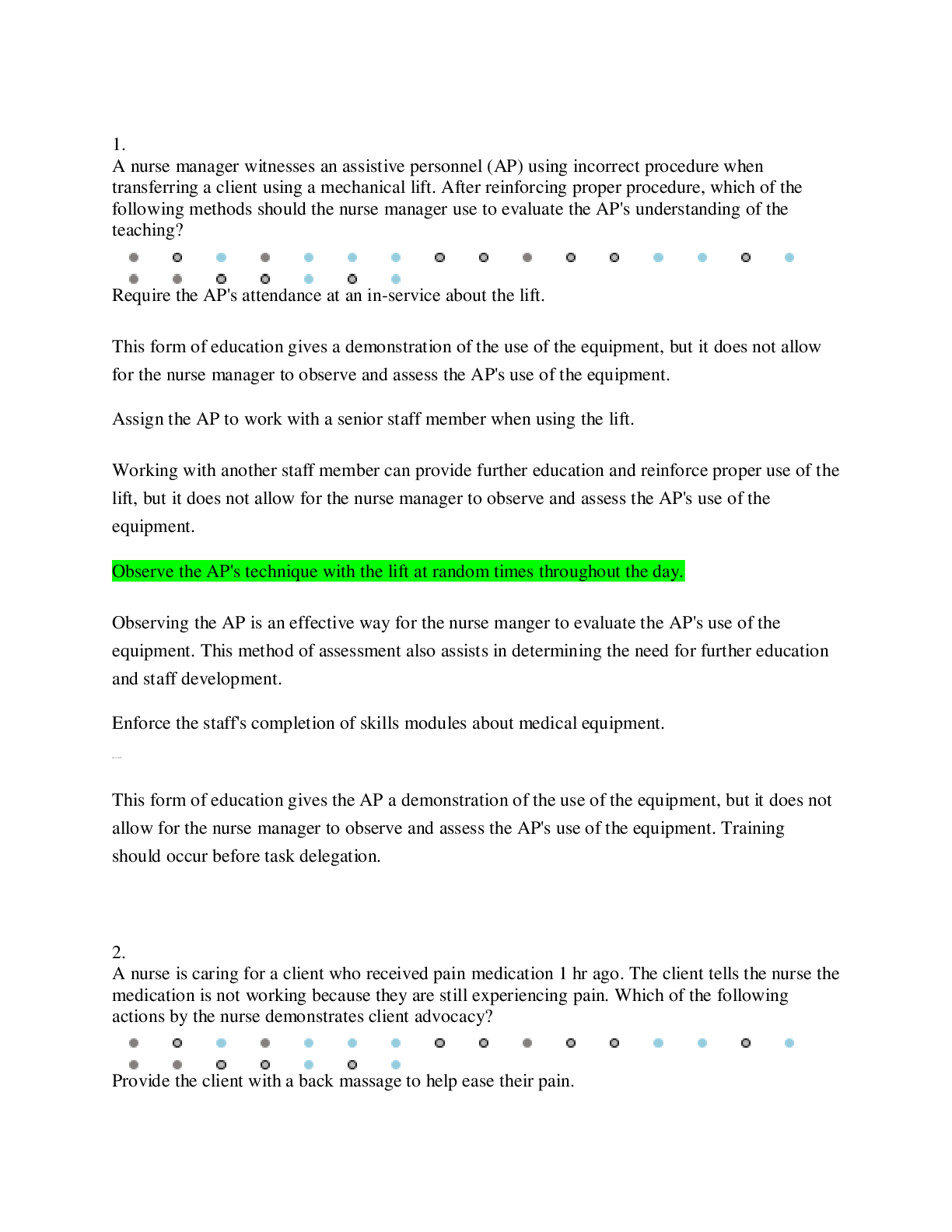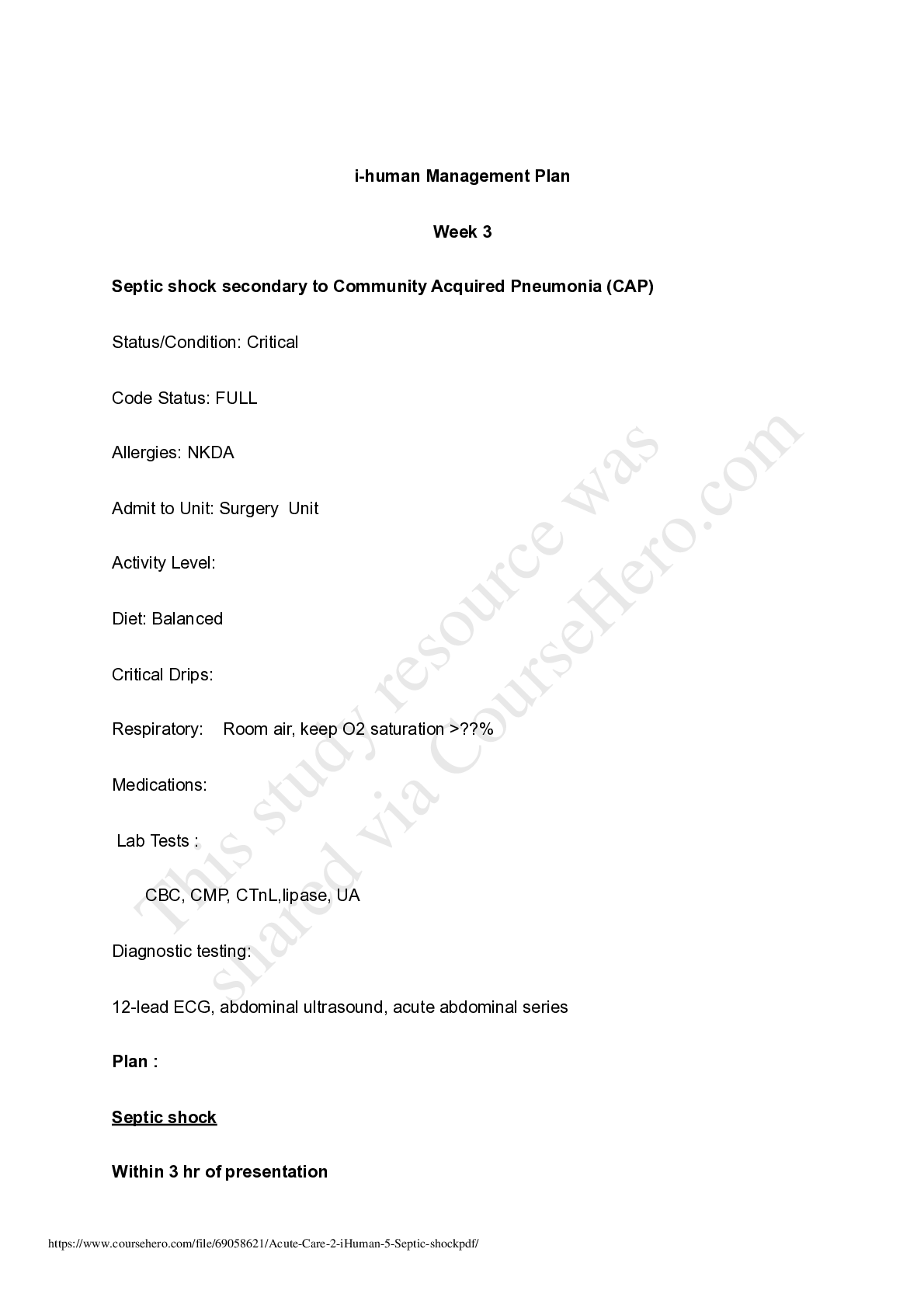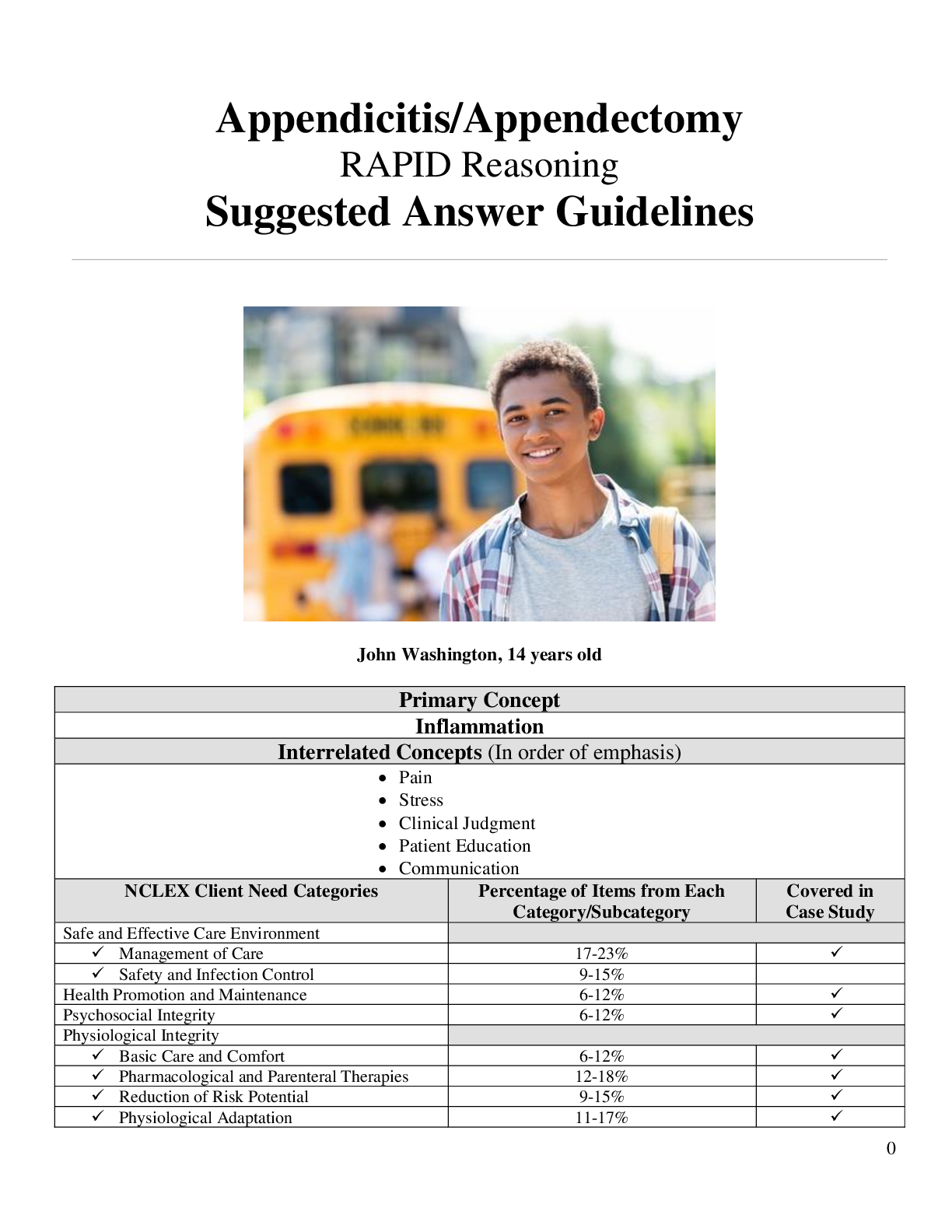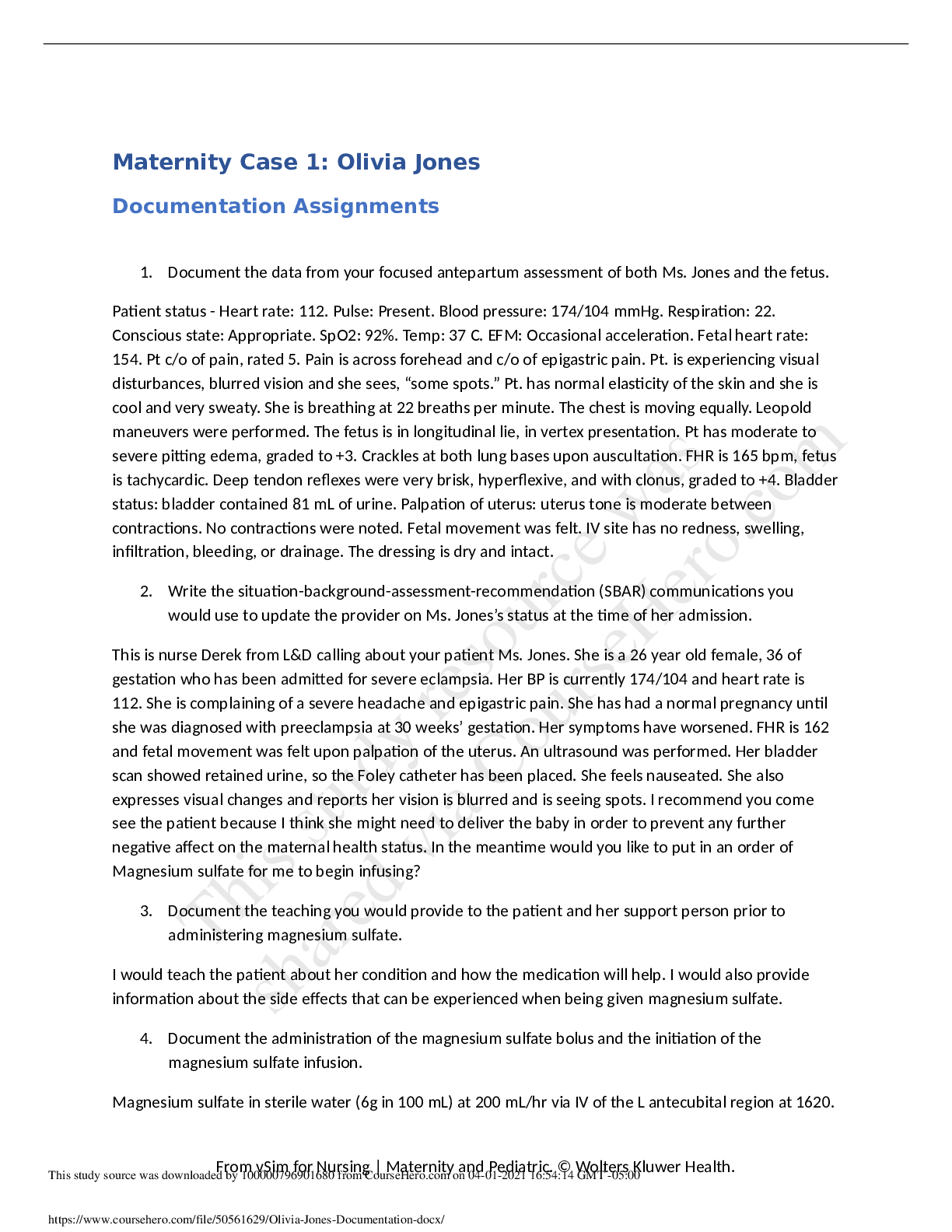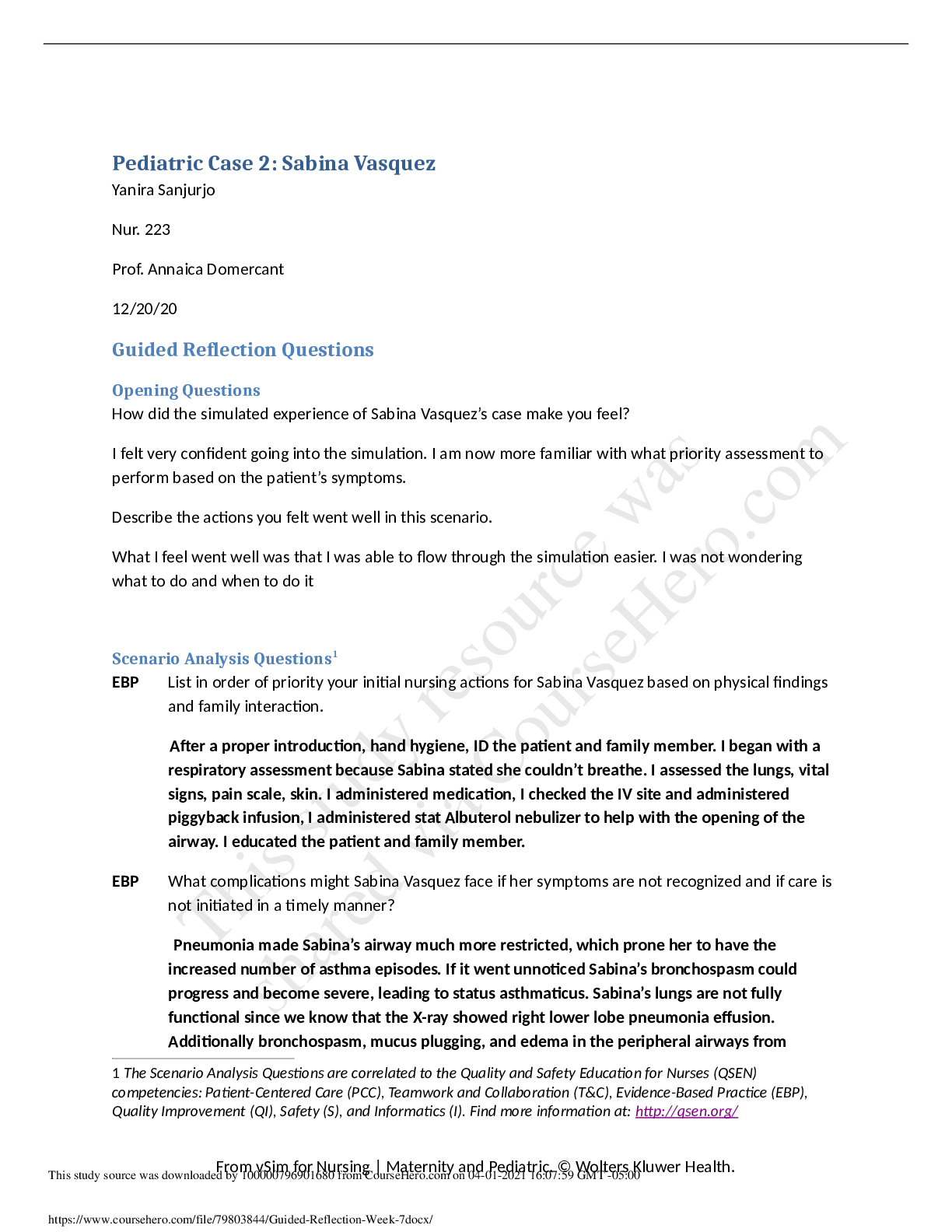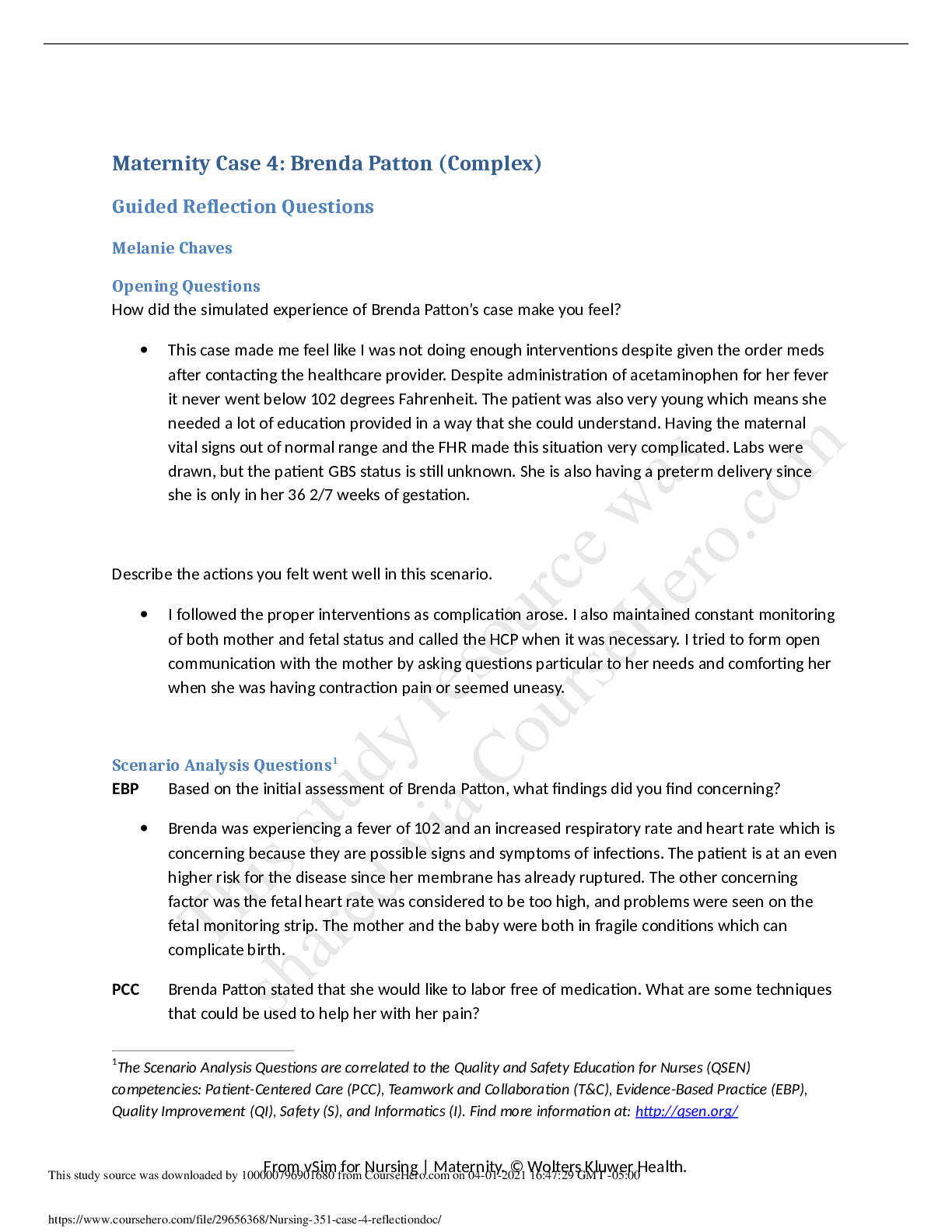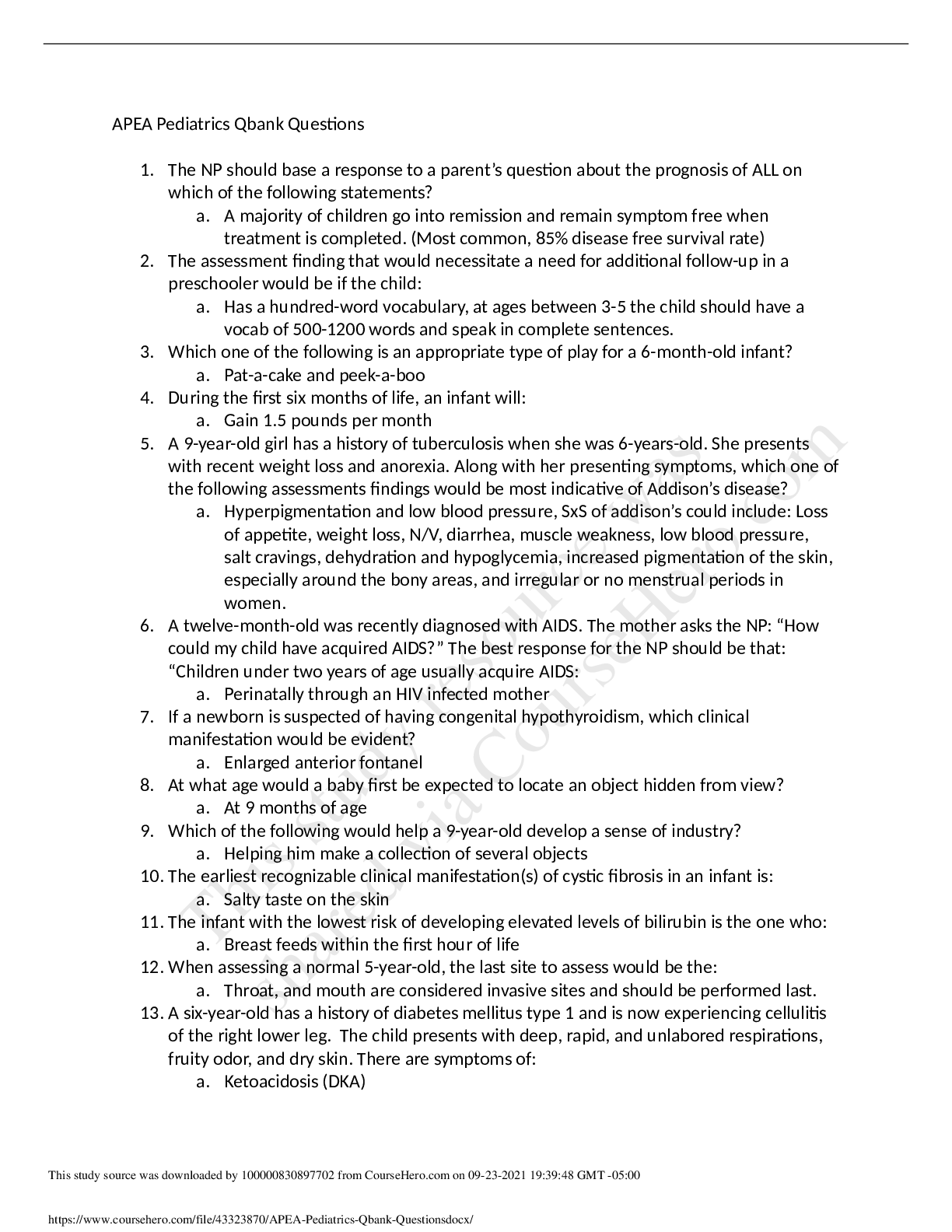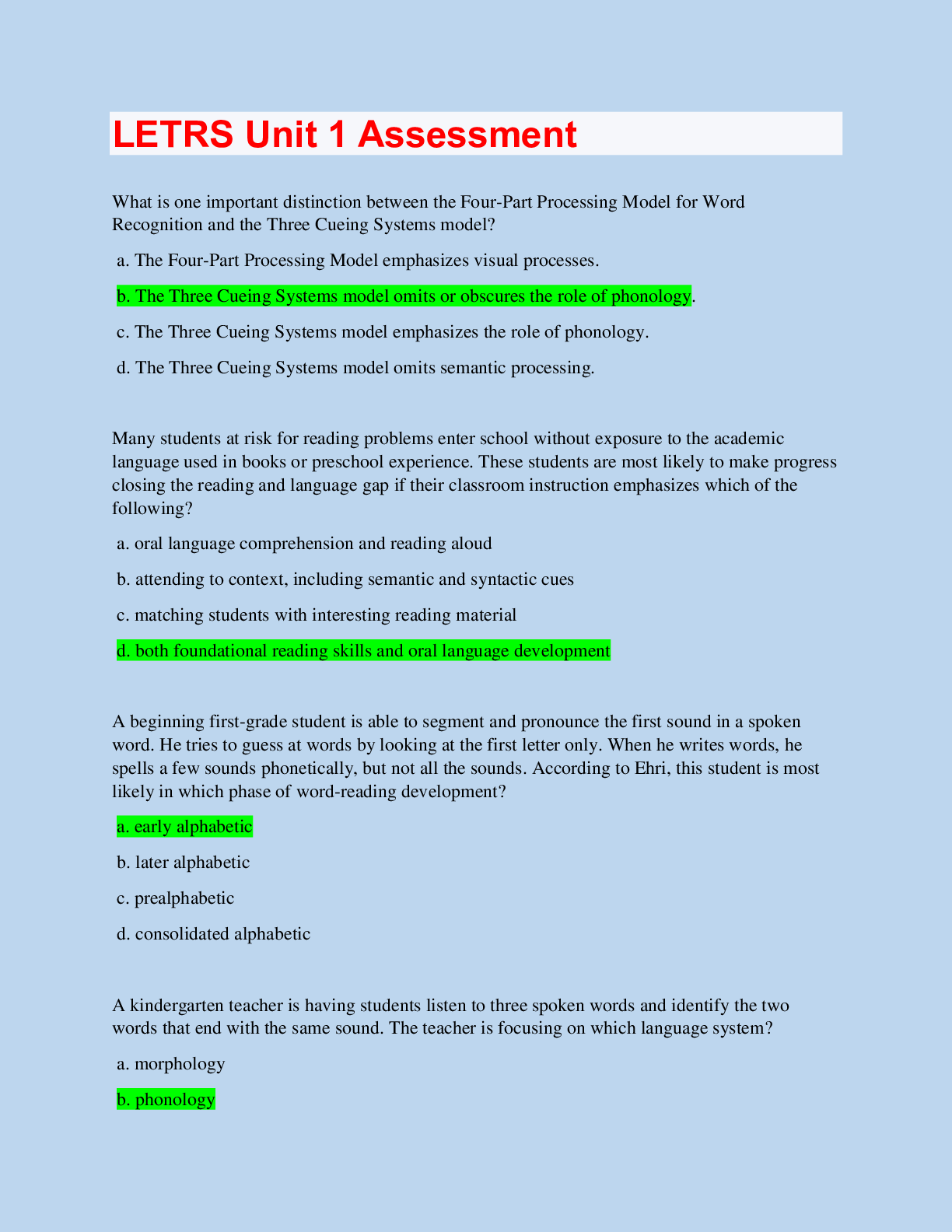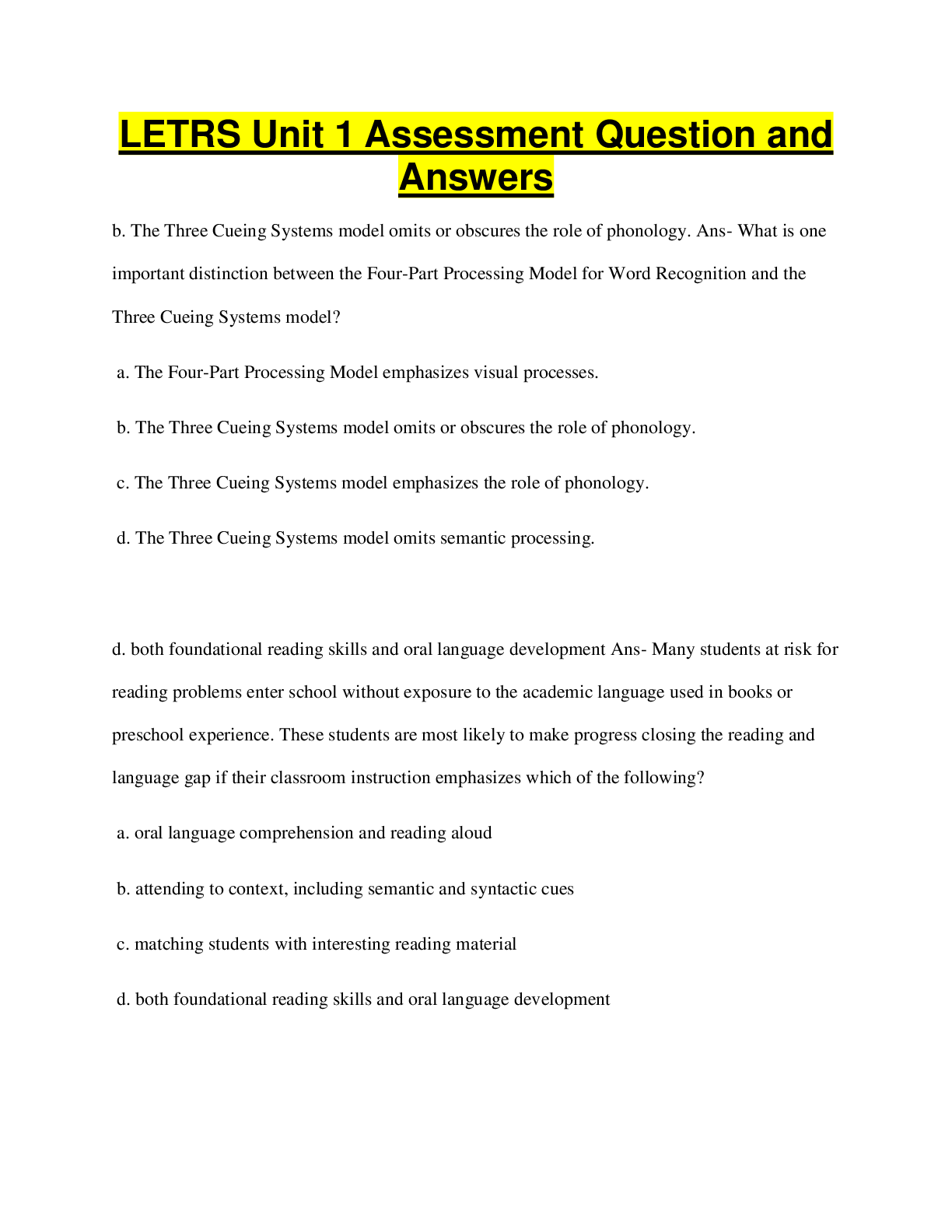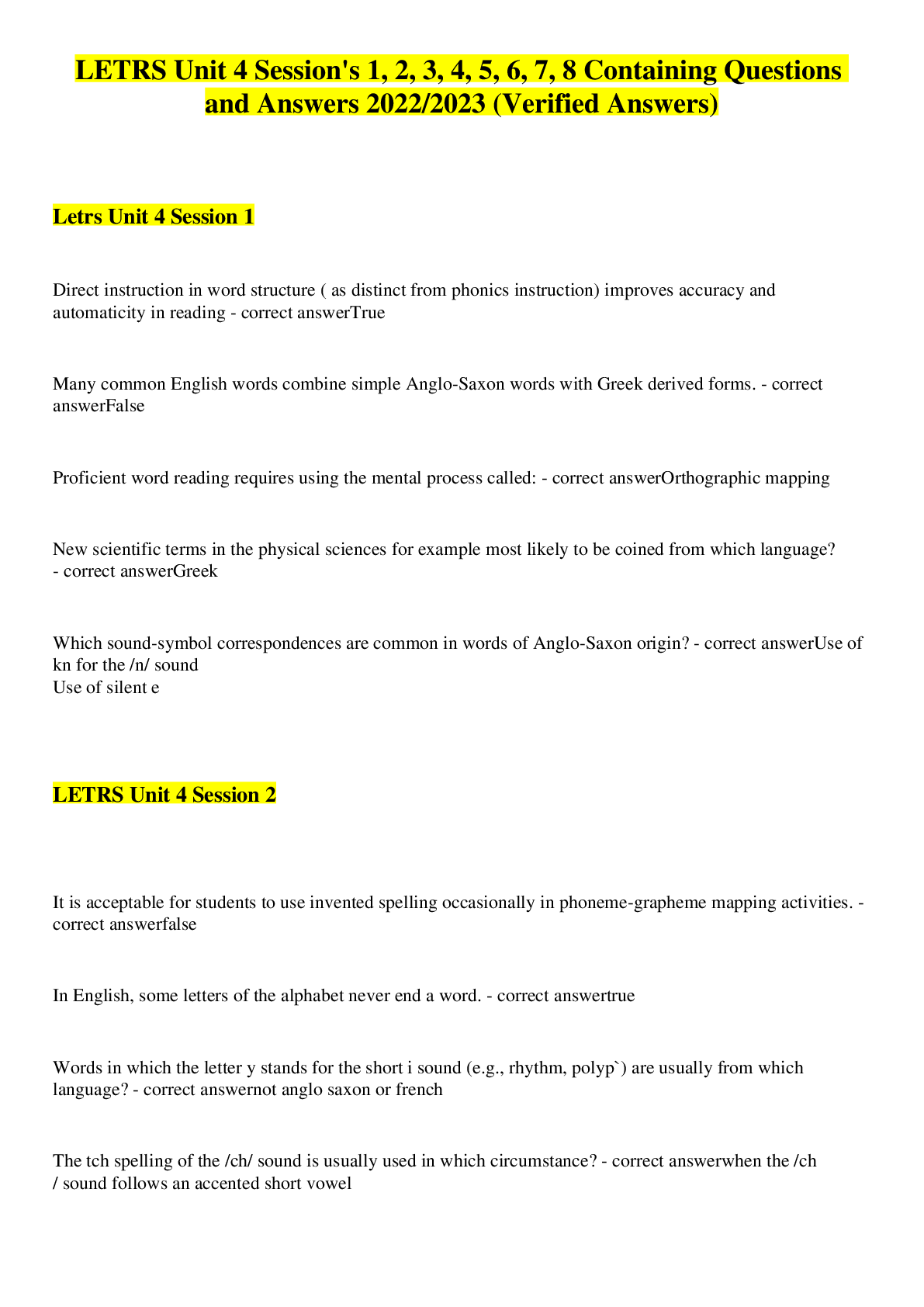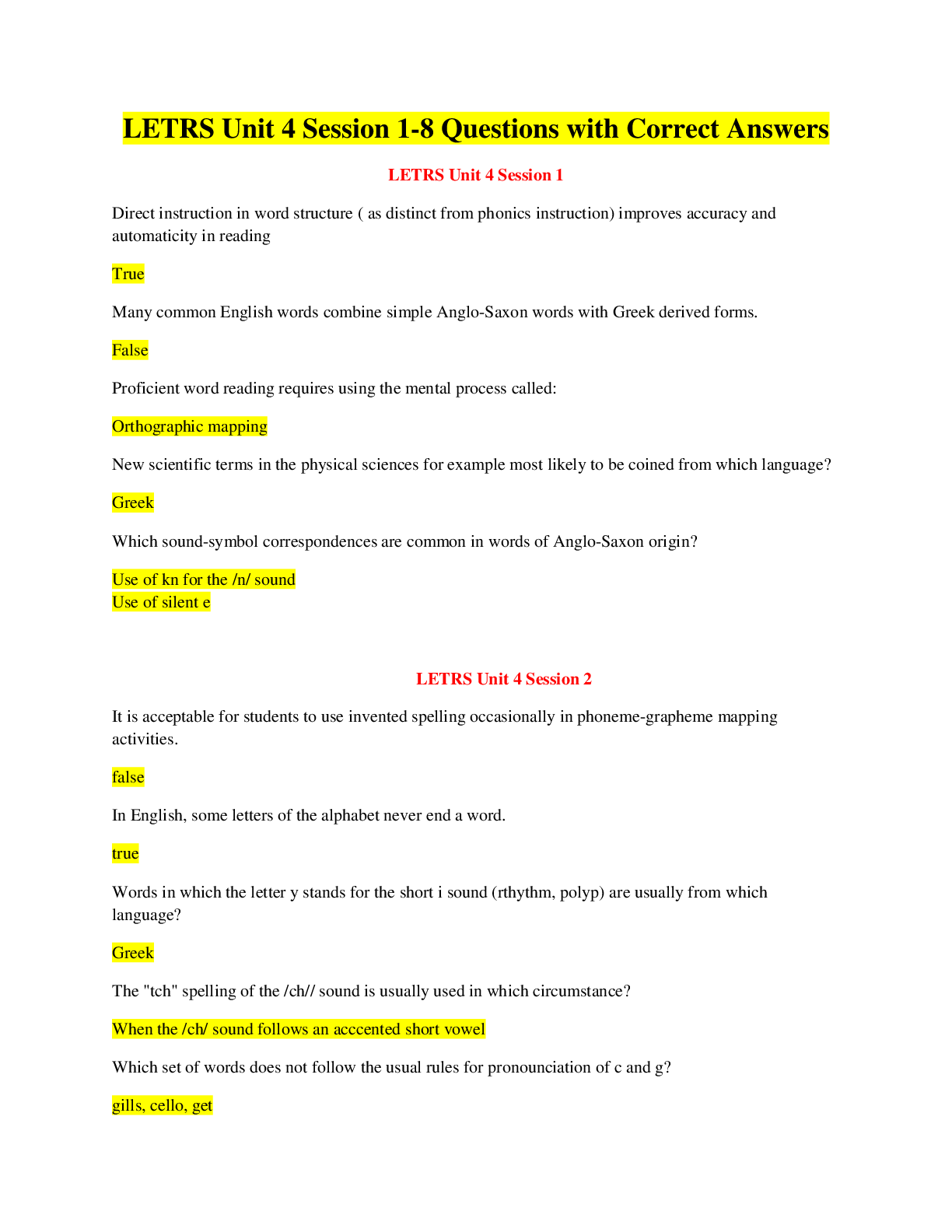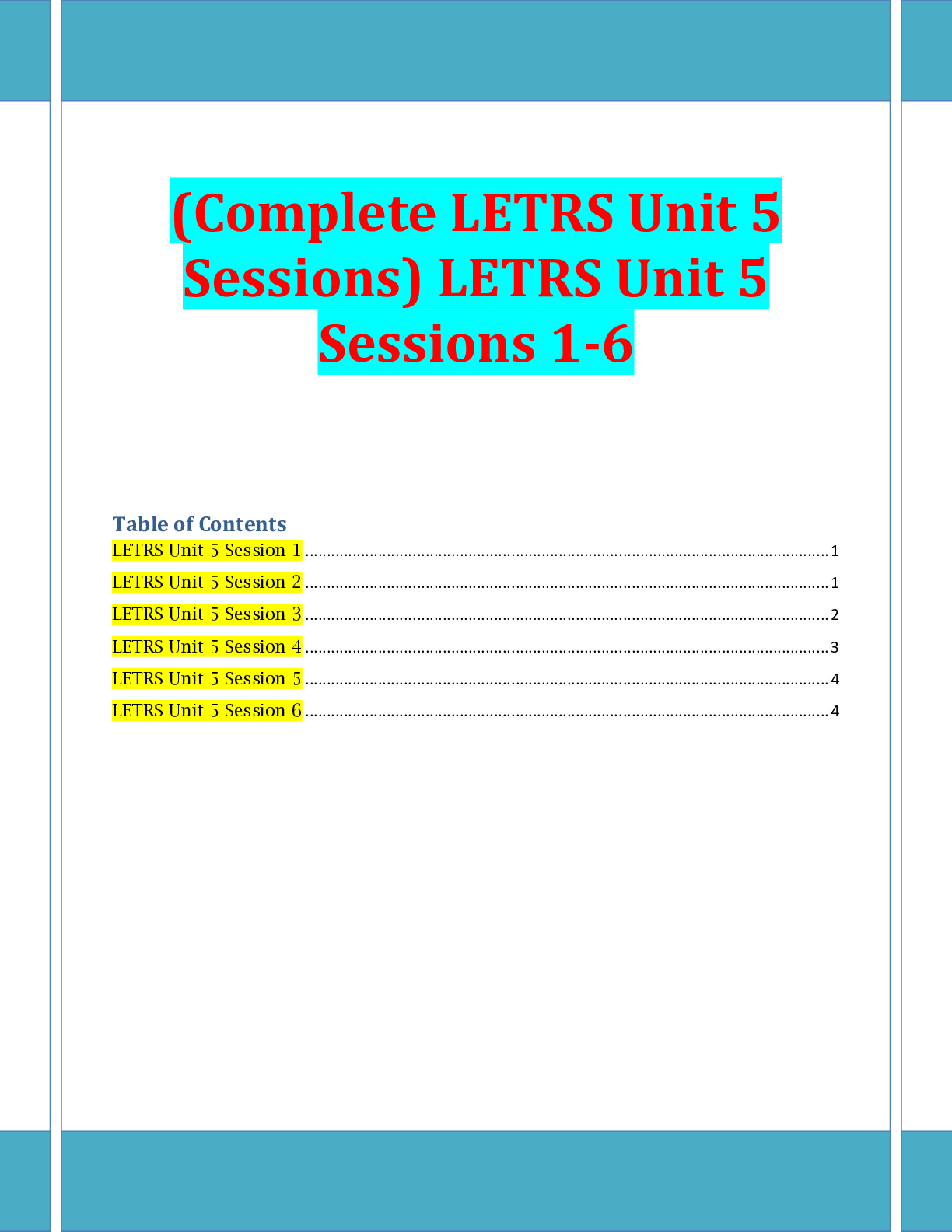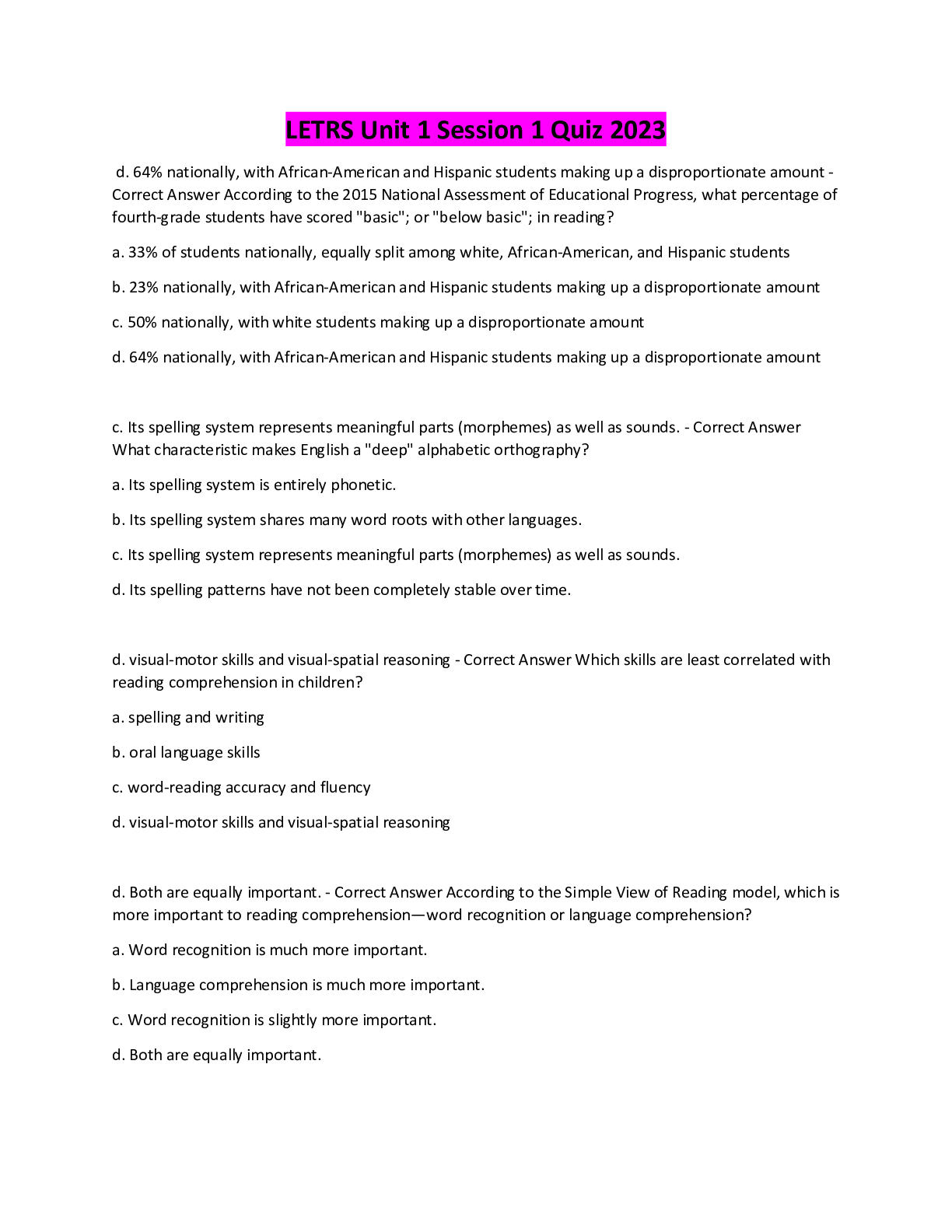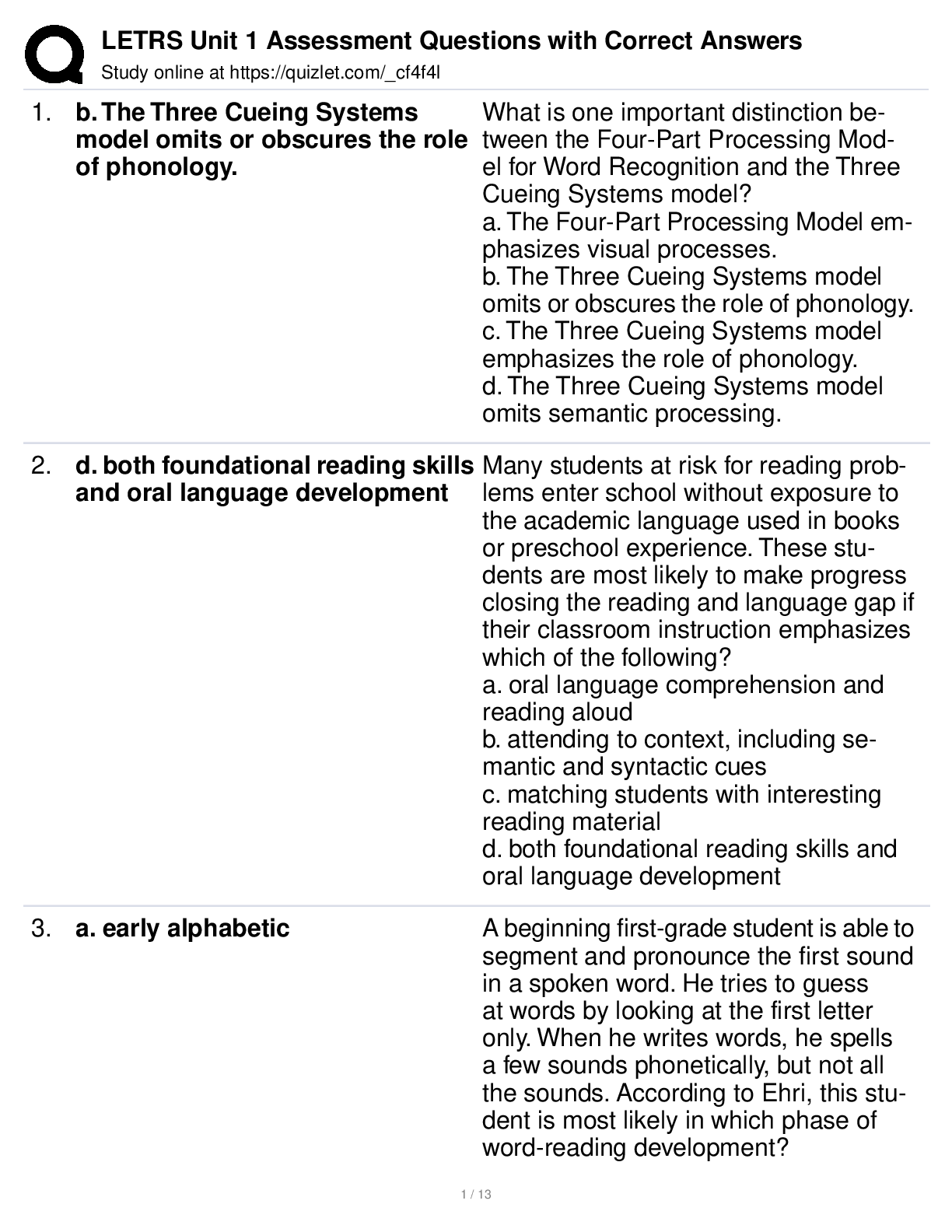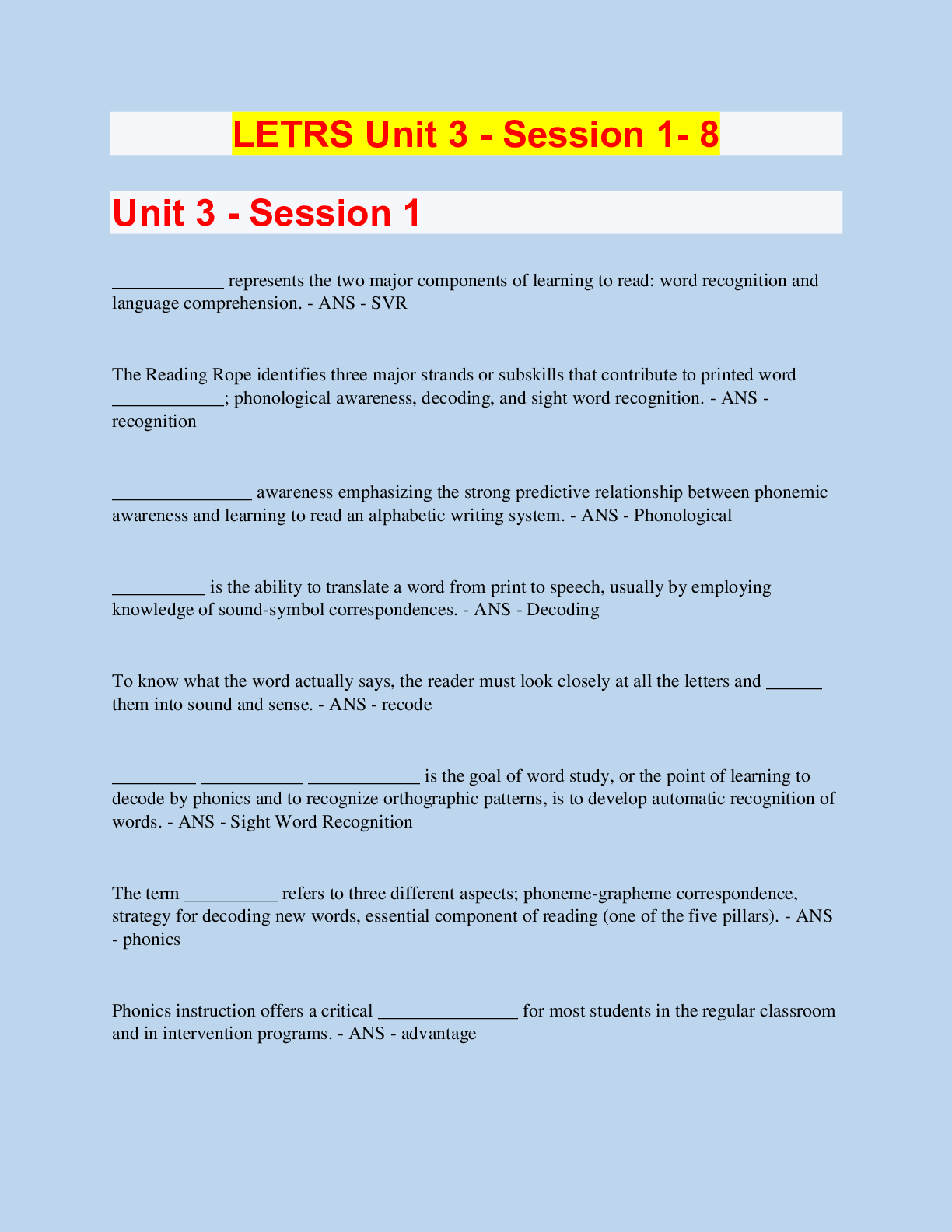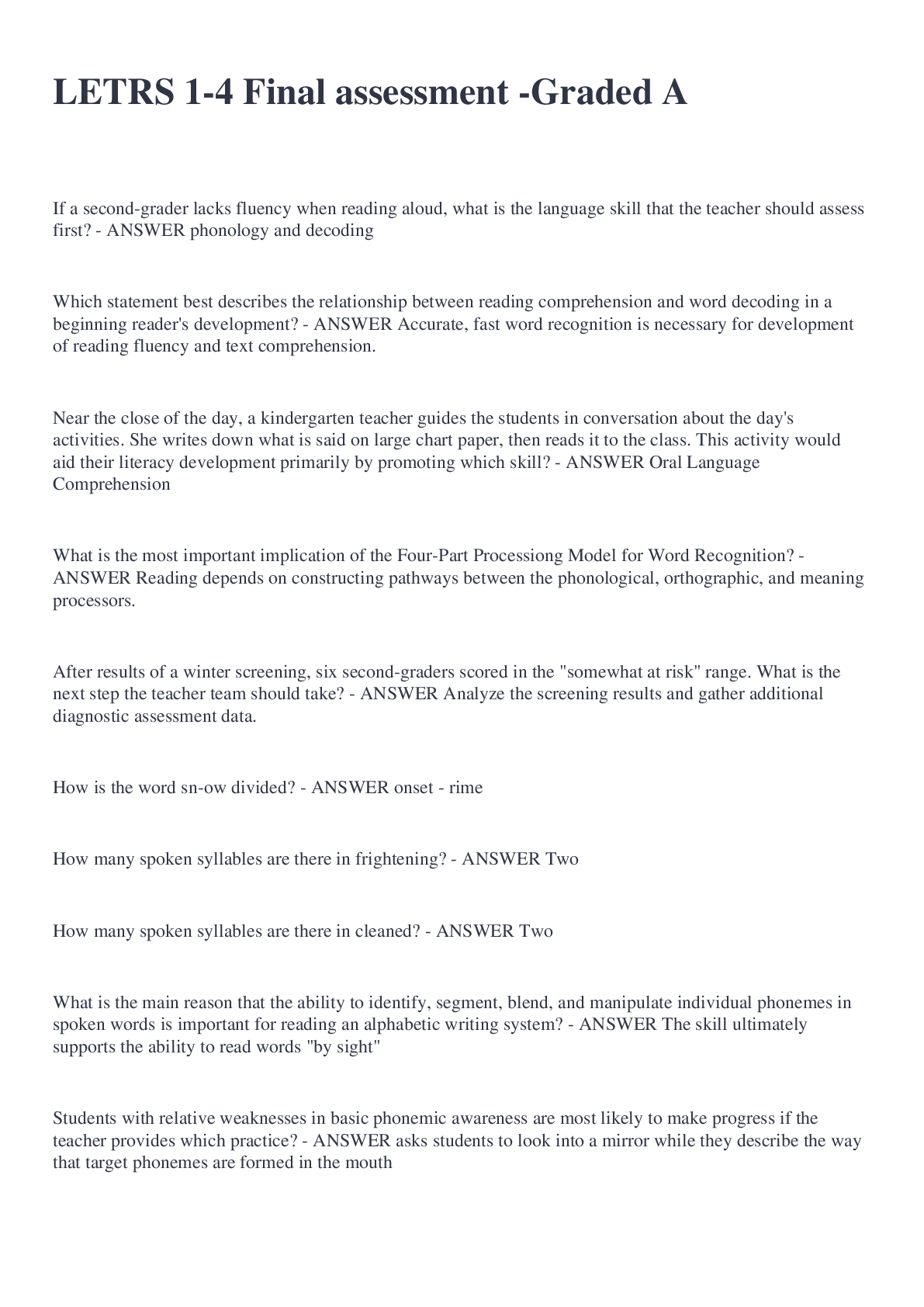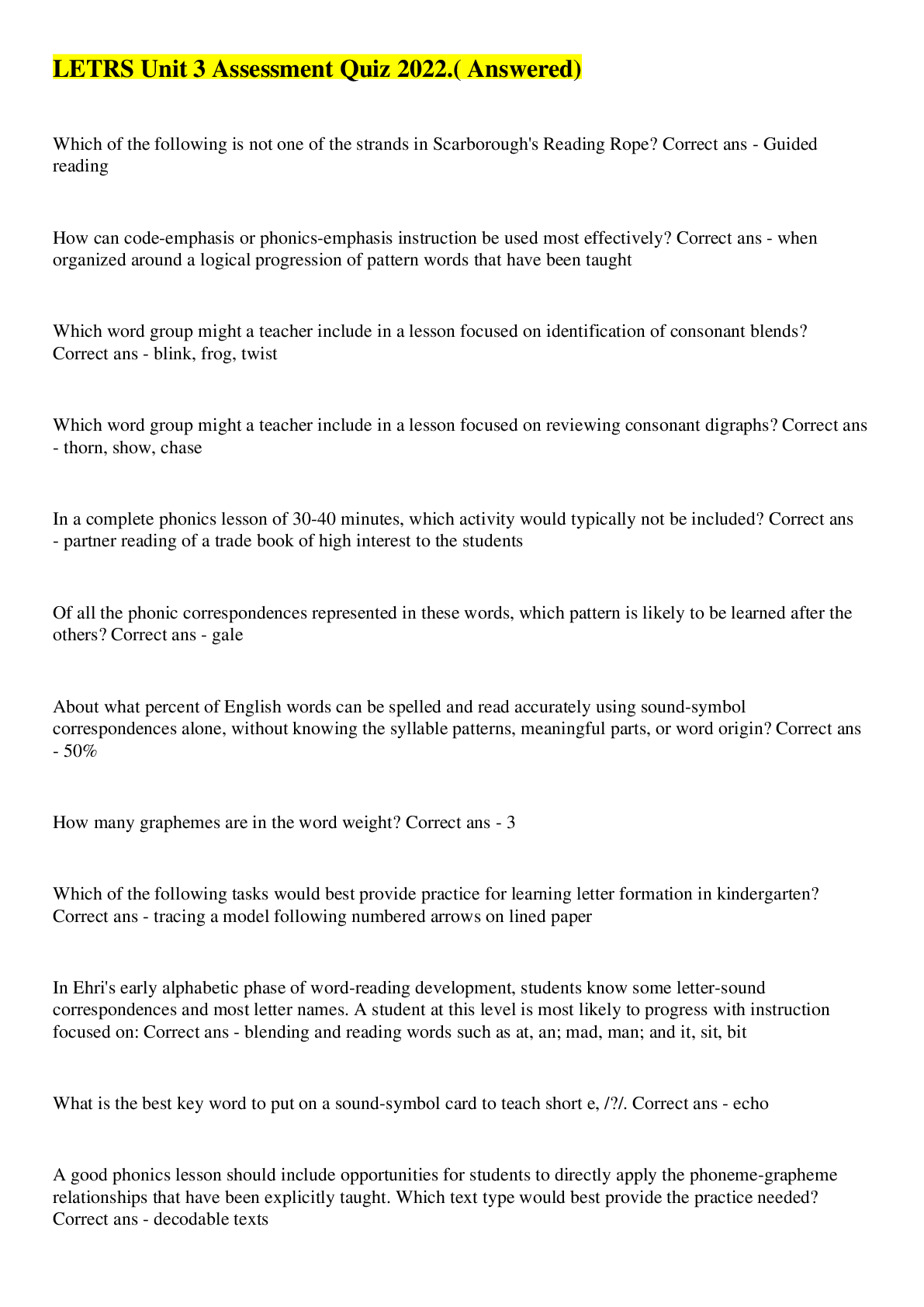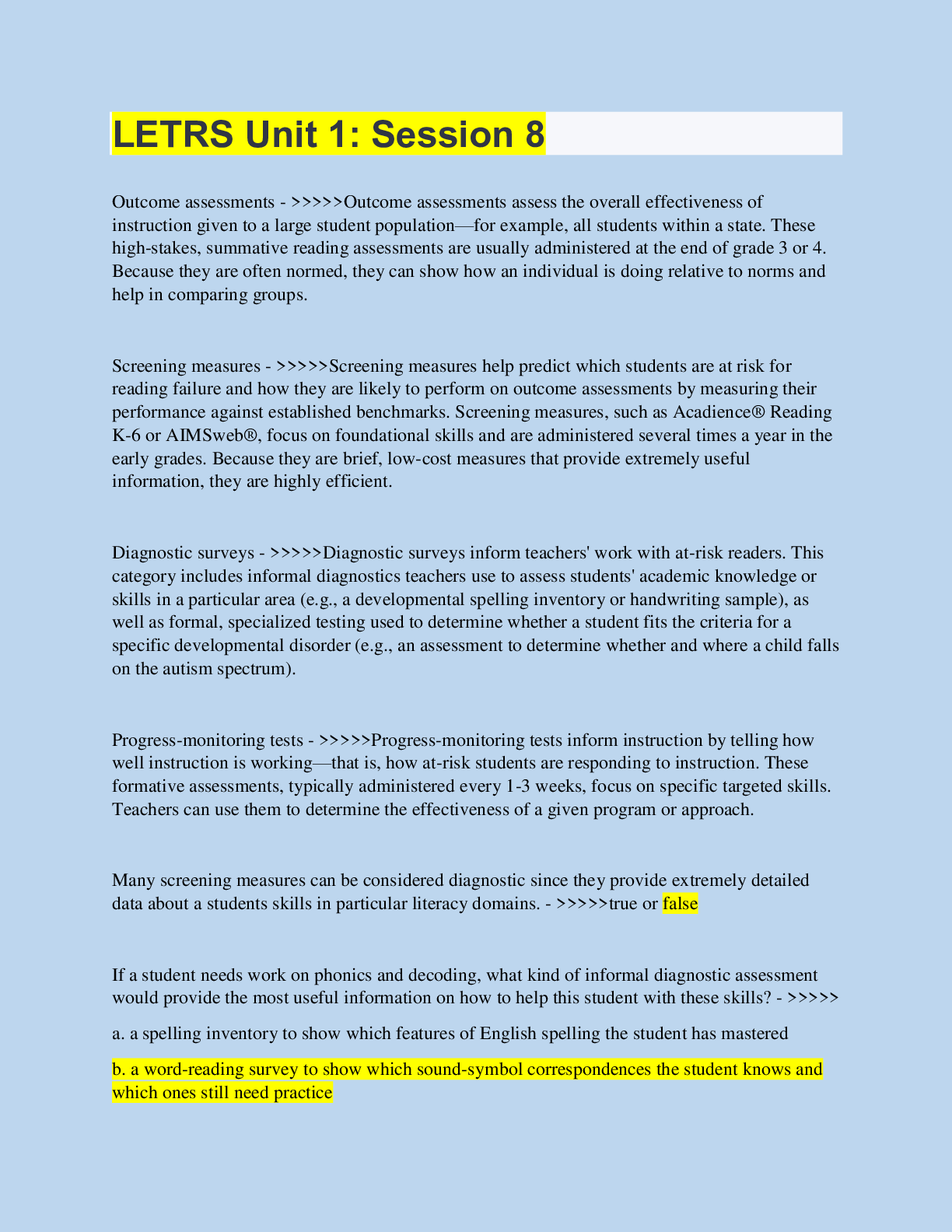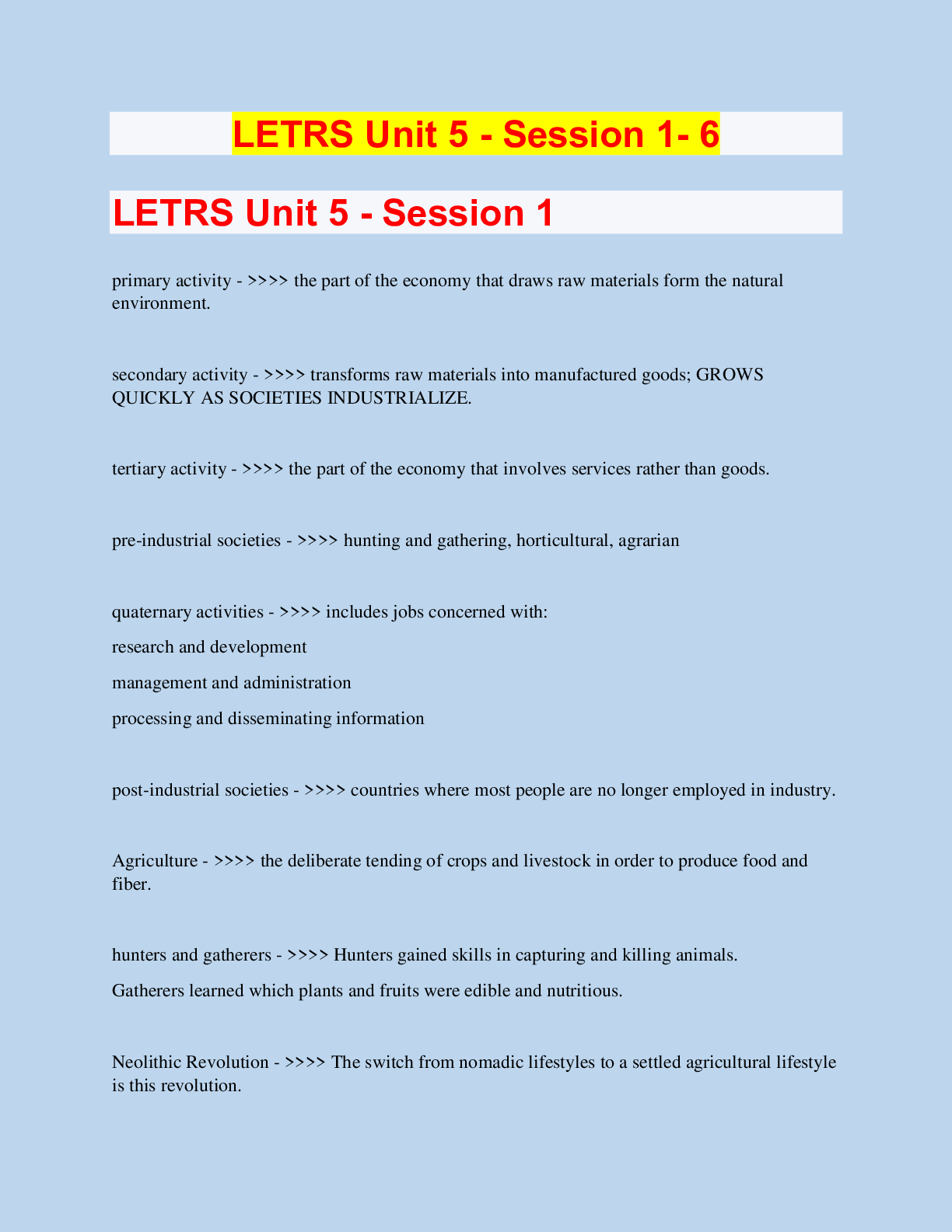BUS 101 Exam 1 Exam One – Summer 2020 Chapters 1 – 4 with complete solution
Document Content and Description Below
BUS 101 Exam 1 Exam One – Summer 2020 Chapters 1 – 4 1) Which environment is NOT an important dimension of a business organization's external environment? A) The political-legal environmen... t B) The sociocultural environment C) The technological environment D) The corporate cultural environment E) The global business environment 2) What is profit? A) Total money taken in by a corporation B) Increases in income from year to year C) Increases in a corporation's stock price D) Revenue generated by goods and services E) Difference between revenues and expenses 3) What is the environment where a firm conducts business known as? A) Global business environment B) Economic environment C) Domestic business environment D) Technological environment E) Political-legal environment 4) What is the general term for resources used by a business to produce a good or service referred to as? A) Labor B) Human Resources C) Human capital D) Factors of production E) Economic systems 5) What term denotes a nation's basis for allocating its resources among its citizens? A) Capital structure B) Economic system C) Ownership processes D) Distribution network E) National regulations 6) What is the process for converting government enterprises into individually owned firms known as? A) Production allocation B) Privatization C) Entrepreneurship D) Demand assessment E) Profit maximization 7) Who is the person who accepts the risks and opportunities inherent in a new business opportunity? A) Capital managers B) Entrepreneurs C) Human resources D) Home country economic systems managers E) Managers 8) What factor of production is used to generate forecasts based on specialized knowledge and economic data? A) Economic resources B) Labor C) Information resources D) Entrepreneurs E) Physical resources 9) When making decisions about production and allocation, which type of system depends on individual producers and consumers to create a combination of supply and demand? A) Planned economy B) Communism C) Private economy D) Market economy E) Socialism 10) Which of the following best explains the difference between a market economy and a planned economy? A) In a planned economy, consumers have little choice in where they work or what they purchase or pay. B) In a market economy, consumers must pay what the market demands. C) Capitalism is the root of a planned economy. D) Market economies are also known as mixed market economies. E) Planned economies promote the use of privatization to increase market share. 11) In which type of economy do the individual producer and consumer control production through supply and demand? A) Planned B) Communist C) Market D) Socialist E) Mixed 12) What is the point at which the supply curve and the demand curve intersect on a graph? A) Equilibrium price B) Decision point C) Surplus price D) Perfect price E) Parity point 13) What is the price at which the quantity of goods demanded and the quantity of goods supplied are equal? A) The going rate B) The margin rate C) The market price D) The optimum price E) The cost price 14) What occurs when the quantity demanded exceeds the quantity supplied? A) Demand deficit B) Surplus C) Equilibrium point D) Shortage E) Supply schedule 15) What marks the key difference between economic systems? A) The way the factors of production are managed B) The way goods are transported within their borders C) The way rules and regulations are legislated D) The way workers are relocated to different regions E) The way basic necessities are determined 16) What is the primary force that determines what a firm buys and sells? A) Laws of supply and demand B) The demand and supply schedule C) Economic resources D) Equilibrium price E) The private enterprise system 17) What are individual beliefs about what is right and wrong or good and bad referred to as? A) Motivators B) Rules C) Cultures D) Ethics E) Laws 18) Which of the following should be the first step in assessing ethical behavior in a certain situation? A) Seek the advice of managers. B) Make a judgment based on the outcome of the activity. C) Consider appropriate moral values. D) Collect facts related to the situation. E) Gather a range of opinions on the effectiveness of the policy. 19) What is likely the single MOST effective step that a company can take to set ethical standards? A) Offer large cash awards for whistle-blowing. B) Suggest that employees take ethics training. C) Post ethical rules on bulletin boards. D) State that the workplace values diversity. E) Demonstrate support from top management. 20) How do top managers BEST demonstrate a commitment to ethical business practices? A) By adopting and enforcing written codes of ethics B) By reading employees' e-mails C) By decentralized decision-making practices D) By cooperating with other companies E) By monitoring employees' Web searches 21) What category of ethics relates to matters such as hiring, firing, working conditions, privacy and respect? A) Behavior toward economic agents B) Behavior toward employees C) Behavior toward the organization D) Elimination of conflicts of interest E) Social responsibility 22) When an activity benefits an individual but not the employer, what ethical dilemma has been created? A) Lack of social responsibility B) Violation of the code of conduct C) Conflict of morals D) Interaction with primary agents of interest E) Conflict of interest 23) What do ethical norms that ensure an action is consistent with what's fair entail? A) Caring B) Morals C) Justice D) Social responsibility E) Economic agents 24) Which ethical norm considers whether a particular act optimizes the benefits to those who are affected by it? A) Utility B) Rights C) Justice D) Caring E) Respect 25) When evaluating a decision based on the ethical norm of rights, a manager is MOST likely to consider which of the following questions? A) Is the decision consistent with what we regard as fair? B) Does the decision respect the individuals involved? C) Is the decision consistent with people's responsibilities to each other? D) Does the decision optimize the benefits for those who are affected by it? E) Does the decision comply with current legislation? 26) Which of the following is the BEST description of organizational stakeholders? A) Competitors B) Government regulators C) The officers and key employees of an organization D) Individuals and businesses who own stock in a company E) Individuals and groups that are directly affected by the practices of a company 27) Standards that help to shape behaviors towards employees, the organization, and other economic agents are A) social responsibility. B) managerial ethics. C) whistle-blowing techniques. D) values. E) morals. 28) Which entity is defined as independent and has little influence on its market? A) Corporation B) Joint venture C) Small business D) Partnership E) Government agency 29) The U.S. Department of Commerce considers a business "small" if it has fewer than how many employees? A) 10 B) 50 C) 100 D) 500 E) 1,500 30) Which of the following industry groups is the fastest growing segment of small business enterprise? A) Manufacturing B) Wholesaling C) Retailing D) Transportation E) Services 31) Which of the following types of venue is favored by small-business retailers? A) Superstore B) Catalog showroom C) Specialty shop D) Department store E) Studio workroom 32) Why is it difficult to compare relative job growth for different-sized businesses? A) Sourcing up-to-date employment figures is difficult. B) Many small businesses experience rapid unreported growth. C) Spheres of influence overlap between the small and big business sectors. D) Staff size of small businesses tends to change faster than staff size of big businesses. E) It is hard to determine the cutoff point at which a small business becomes a large business. 33) Why do attitudes about entrepreneurship vary internationally? A) Decision making in big business can overlook local customs. B) Attitudes towards risk-taking in business are culturally determined. C) Consumer attitudes are influenced by economic cycles. D) Foreign-owned companies can be unresponsive to local markets. E) International business is creating a global village. 34) When an investor is not interested in owning their own business, why do they need to understand entrepreneurship? A) To understand why someone would want to work so hard for a small return B) To determine the key characteristics of success C) To understand how to convert a great idea to a profitable idea D) To assess the market potential for up-and-coming businesses E) To learn how to set up a business plan 35) In a small business, who determines prices for wholesalers and customers? A) Customers B) Franchise owners C) Market forces D) Small business administration E) Small business owner 36) Small businesses impact key aspects of the U.S. economy including A) bank loans, and contributions to big business. B) international trade and the service industry. C) bank loans and innovation. D) the service industry and job creation. E) job creation and innovation. 37) Which of the follow BEST defines those who assume the risk of business ownership? A) Entrepreneurs B) Customers C) Corporate partners D) The Small Business Administration E) Banks 38) What are products that are created abroad and then transported and sold domestically? A) Dumped goods B) Exports C) Imports D) Buy backs E) Domestic goods 39) What are products that are created domestically and transported for sale abroad? A) Dumped goods B) Exports C) Imports D) Buy backs E) Domestic goods 40) Which country is the world's largest marketplace and most stable economy? A) The United States B) Canada C) Germany D) Japan E) China 41) Which country in the Pacific Asia region has one of the world's largest economies? A) South Korea B) China C) Indonesia D) Japan E) Taiwan 42) Which organization was developed to promote economic and cultural cooperation among Asian countries? A) ASEAN B) UAS C) EU D) NAFTA E) ECOWAS 43) Which organization created the classification of countries based on per capita income? A) The World Bank B) The World Trade Organization C) The International Monetary Fund D) The European Union E) The North American Free Trade Agreement 44) Under which of the following treaties are Canada, the United States, and Mexico gradually eliminating tariffs and all other trade barriers? A) The EURO Agreement B) The Pan-American Agreement C) The North American Free Trade Agreement D) The General Agreement on Tariffs and Trade E) The G-3 Free Trade Agreement 45) What organization was founded in 1967 for economic, political, social, and cultural cooperation in the Asia Pacific region? A) SEATO B) ASEAN C) CENTO D) OAS E) WTO 46) Which of the following resulted from NAFTA? A) Companies from other countries, such as Japan, have made fewer business investments in North America. B) U.S. exports to Mexico have decreased. C) Mexican imports to the United States have increased. D) More jobs have been created than what was originally predicted. E) More U.S. jobs were eliminated than what was originally predicted. 47) Which of the following treaties sought to eliminate trade barriers such as tariffs and quotas? A) United Nations Development Assistant Plan B) North American Free Trade Agreement C) General Agreement on Tariffs and Trade D) General Agreement on Trade in Services E) European Union Stability and Growth Pact 48) How does globalization of business benefit shareholders of an organization? A) Through easier and faster international travel B) Through the elimination of dieses in developing nations C) Through increased and improved profitability D) Through lower taxes between trade partners E) Through more distinct cultural heritage 49) What caused manufacturing jobs to move from Mexico to China in the late 1990s? A) Increases in Mexico's cost of living and wages B) Modernization of facilities in China C) Improved international travel abilities D) Increased use of technology in China E) Higher levels of education and professional jobs in Mexico 50) Where is the world's largest free marketplace? A) North America B) South America C) Southeast Asia D) Europe E) Middle East [Show More]
Last updated: 1 year ago
Preview 1 out of 10 pages
.png)
Reviews( 0 )
Document information
Connected school, study & course
About the document
Uploaded On
Dec 09, 2020
Number of pages
10
Written in
Additional information
This document has been written for:
Uploaded
Dec 09, 2020
Downloads
0
Views
50


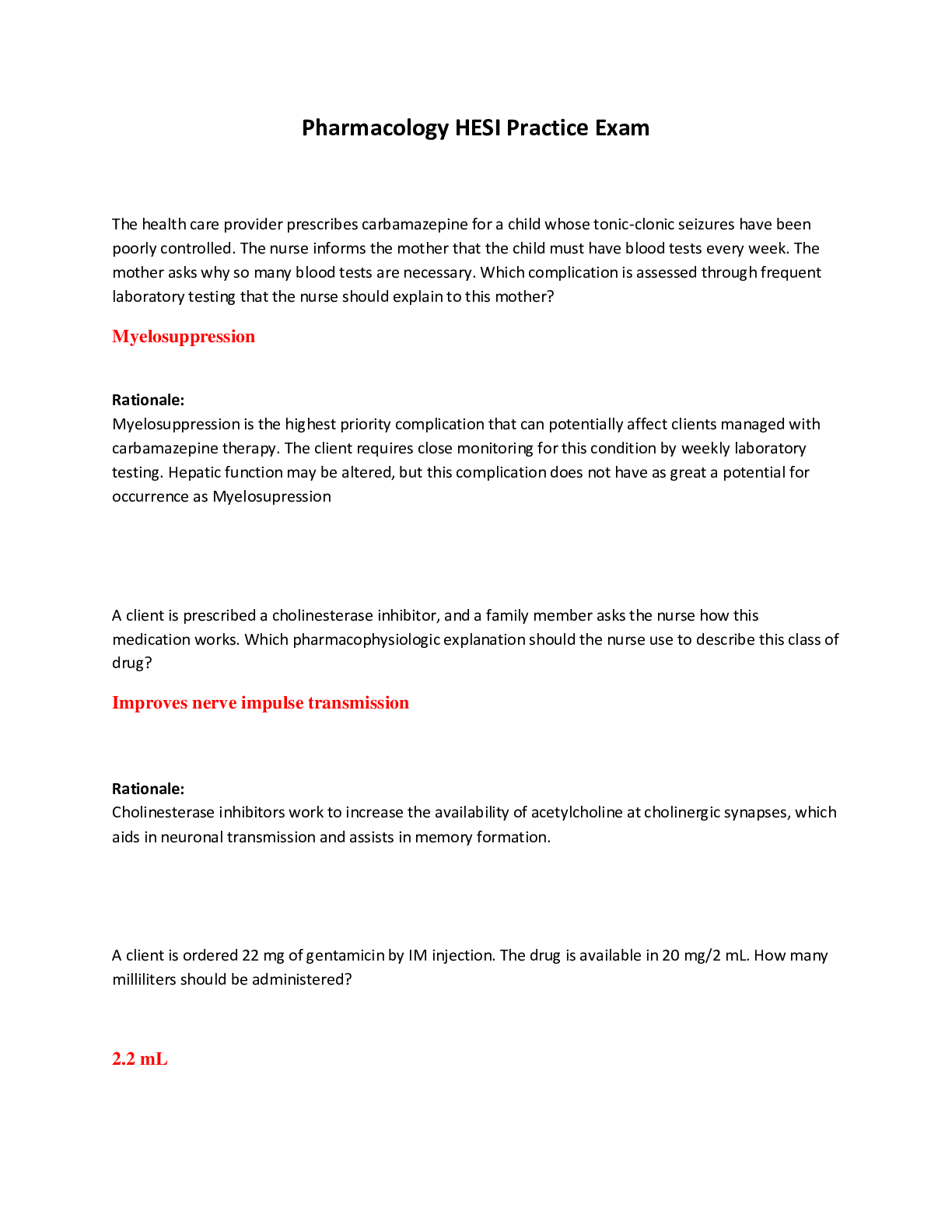
.png)
